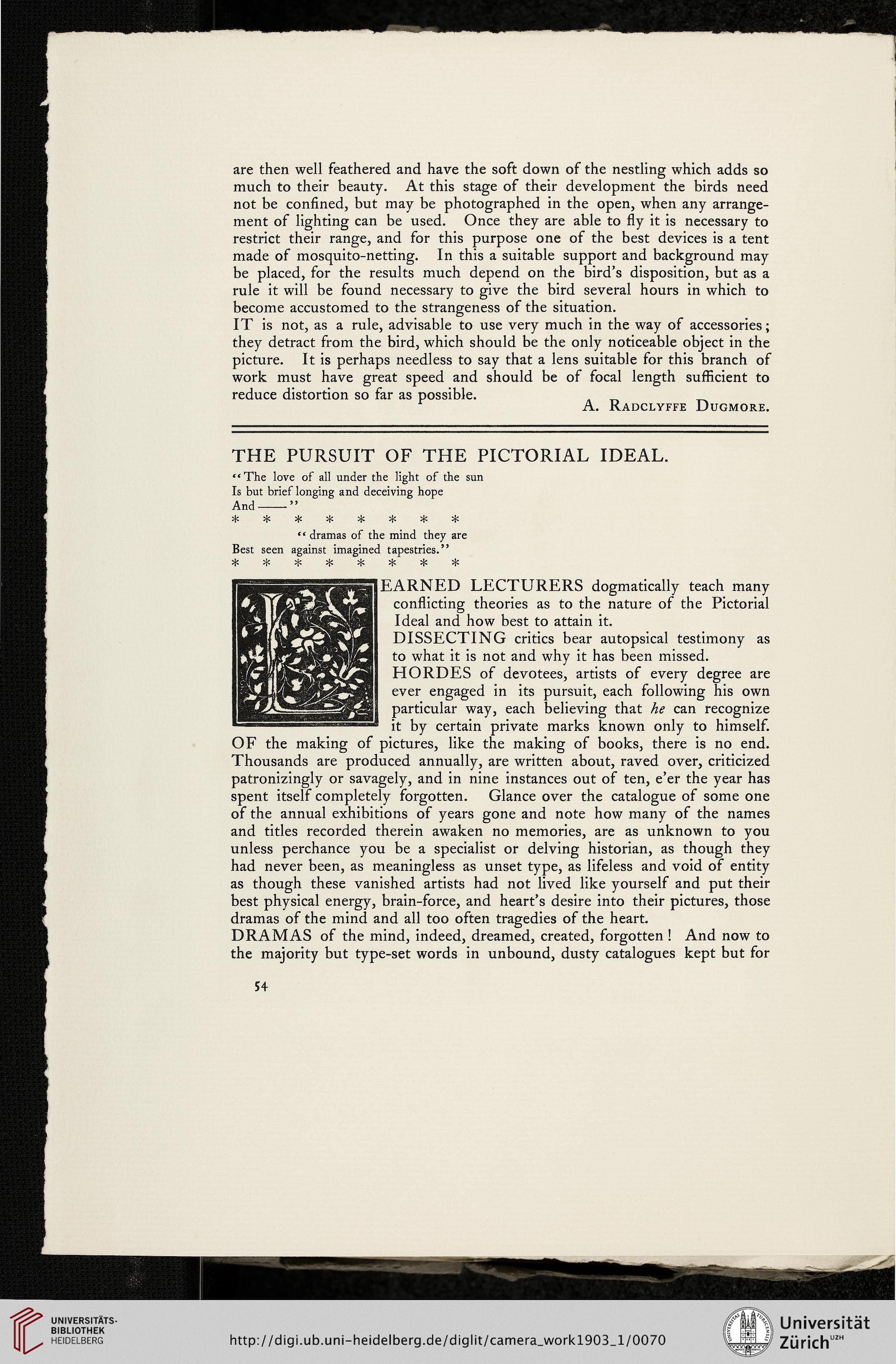Für diese Seite ist auch eine manuell angefertigte Transkription bzw. Edition verfügbar. Bitte wechseln Sie dafür zum Reiter "Transkription" oder "Edition".
are then well feathered and have the soft down of the nestling which adds so
much to their beauty. At this stage of their development the birds need
not be confined, but may be photographed in the open, when any arrange-
ment of lighting can be used. Once they are able to fly it is necessary to
restrict their range, and for this purpose one of the best devices is a tent
made of mosquito-netting. In this a suitable support and background may
be placed, for the results much depend on the bird's disposition, but as a
rule it will be found necessary to give the bird several hours in which to
become accustomed to the strangeness of the situation.
IT is not, as a rule, advisable to use very much in the way of accessories;
they detract from the bird, which should be the only noticeable object in the
picture. It is perhaps needless to say that a lens suitable for this branch of
work must have great speed and should be of focal length sufficient to
reduce distortion so far as possible.
A. Radclyffe Dugmore.
THE PURSUIT OF THE PICTORIAL IDEAL.
“The love of all under the light of the sun
Is but brief longing and deceiving hope
And―”
* * * * * *
“ dramas of the mind they are
Best seen against imagined tapestries.”
* * * * * *
LEARNED LECTURERS dogmatically teach many
conflicting theories as to the nature of the Pictorial
Ideal and how best to attain it.
DISSECTING critics bear autopsical testimony as
to what it is not and why it has been missed.
HORDES of devotees, artists of every degree are
ever engaged in its pursuit, each following his own
particular way, each believing that he can recognize
it by certain private marks known only to himself.
OF the making of pictures, like the making of books, there is no end.
Thousands are produced annually, are written about, raved over, criticized
patronizingly or savagely, and in nine instances out of ten, e’er the year has
spent itself completely forgotten. Glance over the catalogue of some one
of the annual exhibitions of years gone and note how many of the names
and titles recorded therein awaken no memories, are as unknown to you
unless perchance you be a specialist or delving historian, as though they
had never been, as meaningless as unset type, as lifeless and void of entity
as though these vanished artists had not lived like yourself and put their
best physical energy, brain-force, and heart’sdesire into their pictures, those
dramas of the mind and all too often tragedies of the heart.
DRAMAS of the mind, indeed, dreamed, created, forgotten ! And now to
the majority but type-set words in unbound, dusty catalogues kept but for
54
much to their beauty. At this stage of their development the birds need
not be confined, but may be photographed in the open, when any arrange-
ment of lighting can be used. Once they are able to fly it is necessary to
restrict their range, and for this purpose one of the best devices is a tent
made of mosquito-netting. In this a suitable support and background may
be placed, for the results much depend on the bird's disposition, but as a
rule it will be found necessary to give the bird several hours in which to
become accustomed to the strangeness of the situation.
IT is not, as a rule, advisable to use very much in the way of accessories;
they detract from the bird, which should be the only noticeable object in the
picture. It is perhaps needless to say that a lens suitable for this branch of
work must have great speed and should be of focal length sufficient to
reduce distortion so far as possible.
A. Radclyffe Dugmore.
THE PURSUIT OF THE PICTORIAL IDEAL.
“The love of all under the light of the sun
Is but brief longing and deceiving hope
And―”
* * * * * *
“ dramas of the mind they are
Best seen against imagined tapestries.”
* * * * * *
LEARNED LECTURERS dogmatically teach many
conflicting theories as to the nature of the Pictorial
Ideal and how best to attain it.
DISSECTING critics bear autopsical testimony as
to what it is not and why it has been missed.
HORDES of devotees, artists of every degree are
ever engaged in its pursuit, each following his own
particular way, each believing that he can recognize
it by certain private marks known only to himself.
OF the making of pictures, like the making of books, there is no end.
Thousands are produced annually, are written about, raved over, criticized
patronizingly or savagely, and in nine instances out of ten, e’er the year has
spent itself completely forgotten. Glance over the catalogue of some one
of the annual exhibitions of years gone and note how many of the names
and titles recorded therein awaken no memories, are as unknown to you
unless perchance you be a specialist or delving historian, as though they
had never been, as meaningless as unset type, as lifeless and void of entity
as though these vanished artists had not lived like yourself and put their
best physical energy, brain-force, and heart’sdesire into their pictures, those
dramas of the mind and all too often tragedies of the heart.
DRAMAS of the mind, indeed, dreamed, created, forgotten ! And now to
the majority but type-set words in unbound, dusty catalogues kept but for
54



